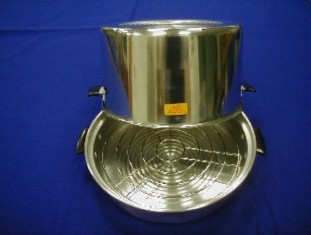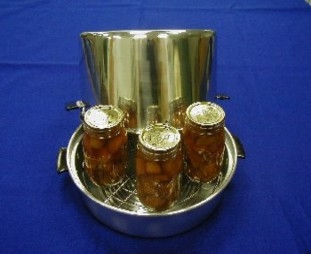Preserving High Acid Foods with a Steam Canner
ID
FST-427NP
Introduction
In September 2015, steam canners were approved for use when canning high acid foods in the home kitchen. Examples of high-acid foods include: apples, pears, pickles, salsa, jams, jellies, etc.
Steam canning has NOT been approved for canning low-acid foods such as carrots, green beans, potatoes, meats, asparagus, corn, beans, etc.
This publication will provide details on how to safely preserve high-acid foods using a steam canner.
What is a steam canner?
A steam canner is a dome style canner that preserves food through exposure to heat produced by steam. This is different from a boiling water bath canner where the jars of food are submerged in boiling water. The steam inside the steam canner vessel reaches 212°F, which is the same temperature as boiling water. The steam canner differs from a pressure canner in that the steam is NOT produced under pressure, therefore, it does not reach a high enough temperature to be safe for processing low- acid foods. It is recommended to use a canner with a built in temperature sensor for accuracy.
It is NOT recommended to use a boiling water bath canner as if it is a steam canner; they are not the same and research has not validated this as a process.


Key Factors
Research conducted by Dr. Elizabeth Andress (National Center for Home Food Preservation at the University of Georgia) and Dr. Barbara Ingham (University of Wisconsin) confirms that steam canners can be safely used in the home kitchen as long as the following key standards are met:
- Foods must be either naturally high in acid, or acidified, with a pH of 4.6 or below.
- A research tested recipe must be used with the atmospheric steam canner. Research- based recipes appropriate for steam canning can be found in the VCE publication “Boiling Water Bath Canning,” or from the National Center for Home Food Preservation. Any recipe created for use with a boiling water bath canner can be used with a steam canner. The instruction booklet that comes with a steam canner does not necessarily provide instructions for safe canning, therefore validated recipes from trusted sources should be used.
- Processing time cannot exceed 45 minutes. Even with changes to processing time to account for elevation, never process any food longer than 45 minutes due to the amount of water in the canner. Never open the steam canner to add water. Make sure to watch the canner and keep it at a temperature of 212°F. A steam canner boiling rapidly can become completely dry within 20 minutes. If the water level becomes too low, the steam canner would need to be refilled with the proper amount of water and the processing time would need to be restarted to ensure a safe product.
- Consider your elevation. Virginia is not flat. Elevation varies from sea level in the Tidewater region to 5,729 feet above sea level at Virginia’s tallest peak – Mount Rogers in Grayson County. Your processing time may need to be changed to reflect your elevation. You can find your elevation here. Add five minutes to your processing time for every 1,000 feet you are above sea level.
- Use tested equipment. Steam canning has been validated using the following models of steam canners: Back to Basics and Victorio. At this time we cannot recommend using any other models of steam canners without additional research.
Additional Considerations
The jars must stay hot prior to processing. To do this, heat them before filling, fill with hot liquid, and try to prevent colling as much as possible before placing in the canner.
Processing begins once pure steam is formed (212°F), therefore the temperature needs to be strictly monitored. To correctly fill the canner with steam, it must be vented before the processing time can be started. The canner is properly vented when a full column of steam (6-8 inches) is observed venting from holes in the side of the canner. This venting should continue throughout the entire process.
After processing in the steam canner, cool them in a draft-free location at room temperature. Cooling is important for a safe, secure seal which is an essential part of the canning process.
Jars should be lifted from the steam canning with a jar lifter
Place jars 3-4 inches apart on a thick kitchen towel for adequate air flow. Do not use a plastic mat and do not place jars directly on the countertop as any sudden temperature change can cause the jar to break
Allow jars to sit undisturbed for 12-24 hours to cool
Do not remove ring bands or test the seal until the cooling is complete
Test the jar seals after cooling is complete by pressing the center of the lid or tapping the lid with a spoon. The lid should stay down and give a clean ringing sound when tapped. If it makes a dull sound, the lid is not sealed. If a jar is not sealed, reprocesses within 24 hours or refrigerate and consume within three days.
Remove ring bands from sealed, cooled jars. Ring bands can be washed, dried, and put away to use another time. Wash jars and lids to remove all residues. Label jars with the date it was prepared/processed and the contents. Store in a cool, dry place out of direct light. The ideal temperature to store unopened jars is 50°-70°F. Once opened, keep jars in the refrigerator as you consume the contents.
References
Ingham, B. 2017. Safe Preserving: Using a Steam Canner. Available at: https://fyi.extension.wisc.edu/safefood/2017/10/24/safe-preserving-using-a-steam- canner/?ss_redir=1. Accessed April 20, 2022.
Ingham, B. 2019. Guidelines for using a Steam Canner for Home Food Preservation. Available at: https://fyi.extension.wisc.edu/safepreserving/files/2019/04/SteamCannerGuidelinesFeb2019.pdf. Accessed April 20, 2022.
Ingham, B. 2020. An update on safe use of steam canners. Available at: https://fyi.extension.wisc.edu/safefood/2020/08/18/an-update-on-safe-use-of-steam-canners/. Accessed April 20, 2022.
National Center for Home Food Preservation. 2015. Burning issue: Using atmospheric steam canners. Available at: http://nchfp.uga.edu/publications/nchfp/factsheets/steam_canners.html. Accessed April 20, 2022.
Willmore, P., M. Etzel, E. Andress and B. Ingham.
2015. Home processing of acid foods in atmospheric steam and boiling water canners. Food Protection Trends. 35:150-160.
Additional Resources
Boyer, R. and J. McKinney. 2018. Boiling Water Bath Canning. 948-954 (FST-304P). https://www.pubs.ext.vt.edu/content/dam/pubs_ext_vt_edu/348/348-594/FST-304.pdf
Boyer, R. and M. Chase. 2016. Pressure Canning. 348-585 (FST-222).
https://www.pubs.ext.vt.edu/content/dam/pubs_ext_vt_edu/348/348-585/348-585-PDF.pdf
National Center for Home Food Preservation. 2020. Find Your Altitude. Available at: https://nchfp.uga.edu/how/general/find_altitude.html
National Center for Home Food Preservation. 2022. How Do I…Can? Available at: https://nchfp.uga.edu/how/can_home.html
Virginia Cooperative Extension materials are available for public use, reprint, or citation without further permission, provided the use includes credit to the author and to Virginia Cooperative Extension, Virginia Tech, and Virginia State University.
Virginia Cooperative Extension is a partnership of Virginia Tech, Virginia State University, the U.S. Department of Agriculture (USDA), and local governments, and is an equal opportunity employer. For the full non-discrimination statement, please visit ext.vt.edu/accessibility.
Publication Date
May 10, 2022



